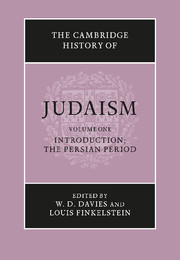Book contents
- Frontmatter
- INTRODUCTION
- THE PERSIAN PERIOD
- 4 The Persian empire and the political and social history of Palestine in the Persian period
- 5 The archeology of Persian palestine
- 6 Hebrew and Aramaic in the Persian period
- 7 The Jewish community in Palestine in the Persian period
- 8 Prophecy and Psalms in the Persian period
- 9 Wisdom literature in the Persian period
- 10 Jewish religious life in the Persian period
- 11 Persian religion in the Achemenid age
- 12 Iranian influence on Judaism: first century B.C.E. to second century C.E.
- 13 The Diaspora
- Bibliographies
- Chronological Table
- Index
- References
12 - Iranian influence on Judaism: first century B.C.E. to second century C.E.
from THE PERSIAN PERIOD
Published online by Cambridge University Press: 28 March 2008
- Frontmatter
- INTRODUCTION
- THE PERSIAN PERIOD
- 4 The Persian empire and the political and social history of Palestine in the Persian period
- 5 The archeology of Persian palestine
- 6 Hebrew and Aramaic in the Persian period
- 7 The Jewish community in Palestine in the Persian period
- 8 Prophecy and Psalms in the Persian period
- 9 Wisdom literature in the Persian period
- 10 Jewish religious life in the Persian period
- 11 Persian religion in the Achemenid age
- 12 Iranian influence on Judaism: first century B.C.E. to second century C.E.
- 13 The Diaspora
- Bibliographies
- Chronological Table
- Index
- References
Summary
INTRODUCTION: THE PROBLEM AND THE METHOD
The fact that in the latter part of the Second Temple period Judaism was undergoing far-reaching changes and developing new aspects, trends, themes and ideas, which were to be retained in part as belonging to the permanent stock of Jewish life and thought, has long attracted the attention of students of Judaism. The most obvious of these changes was in the use of language – the structure, syntax, morphology and lexicon of the later writings in Hebrew display differences which put them apart from the earlier books, and a new language was added to the range of sacred expression, which figures already in some of the later biblical books. These outward changes reflect some of the adjustments made necessary by the new situation of the world: the creation of the world empire of the Persians, their adoption of Aramaic as an official language for purposes of international communication, and the fact that both Hebrew and Aramaic absorbed a great number of Persian words and coined certain expressions under the influence of Persian, as they also did subsequently under that of Greek. Many of these words and expressions were, naturally, in the field of government and administrative practice, but this was by no means the only field in which this linguistic impact was present. We have some words belonging to general civilian life, as well as some which became part of the Jewish religious terminology, although they were not exclusively of religious significance in their original linguistic background (for example, raz pardes, nahŔir).
- Type
- Chapter
- Information
- The Cambridge History of Judaism , pp. 308 - 325Publisher: Cambridge University PressPrint publication year: 1984
References
- 7
- Cited by

